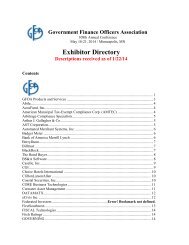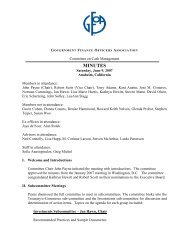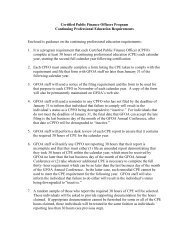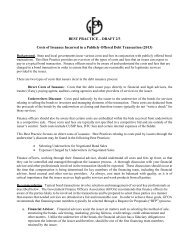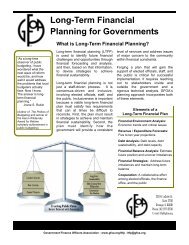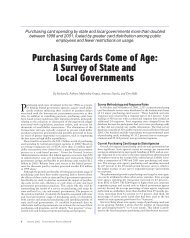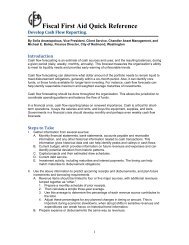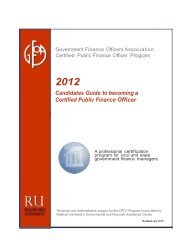OPEB IN PERSPECTIVE - Government Finance Officers Association
OPEB IN PERSPECTIVE - Government Finance Officers Association
OPEB IN PERSPECTIVE - Government Finance Officers Association
Create successful ePaper yourself
Turn your PDF publications into a flip-book with our unique Google optimized e-Paper software.
STEPHEN J. GAUTHIER<br />
<strong>OPEB</strong> <strong>IN</strong> <strong>PERSPECTIVE</strong><br />
GASB Statement No. 45 Four Years Later
Typically, a new accounting standard generates limited<br />
interest,at best,from those outside the accounting and<br />
auditing profession. Even the introduction of a new<br />
governmental financial reporting model in 1999 seems to<br />
have elicited only passing interest from those not directly<br />
involved in its implementation. Such was certainly not the<br />
case,however,when the <strong>Government</strong>al Accounting Standards<br />
Board (GASB) issued Statement No. 45, Accounting and<br />
Financial Reporting by Employers for Postemployment Benefits<br />
Other Than Pensions in July 2004. It seems safe to say that no<br />
other public-sector financial reporting standard in recent<br />
memory has evoked more interest (and passion!) on the part<br />
of those not otherwise professionally involved with accounting<br />
and auditing. Moreover, in the four years since the standard<br />
was issued, the level of interest seems to have increased<br />
rather than diminished.<br />
The release of GASB Statement No. 45 was met with considerable<br />
misunderstanding. Happily, much of the confusion<br />
appears to be dissipating as governments approach the deadline<br />
for implementation (from the fiscal year ending<br />
December 31, 2007, for the largest governments to the fiscal<br />
year ending December 31, 2009, for the smallest).Accordingly,<br />
now appears a good time to reconsider GASB Statement No.45<br />
in the light of all that has been learned over the past four years.<br />
PENSIONS V. <strong>OPEB</strong>:<br />
A TALE OF TWO BENEFITS<br />
Other postemployment benefits (<strong>OPEB</strong>) such as retirement<br />
health care are essentially similar to pensions in that both<br />
constitute a form of compensation to employees for services<br />
rendered. All the same, there are important practical differences<br />
between these two types of postemployment benefits.<br />
Defined benefit pension benefits are provided to employees<br />
pursuant to a formal contractual arrangement between<br />
employer and employees that cannot be unilaterally altered.<br />
<strong>OPEB</strong>, on the other hand, typically allow for considerable<br />
employer flexibility. Indeed, employers often are free, in principle,<br />
to drop <strong>OPEB</strong> altogether, at their sole discretion. Also,<br />
there has long been a consensus that pensions should be prefunded,<br />
whereas <strong>OPEB</strong> have historically been financed<br />
almost universally on a pay-as-you-go basis.<br />
These differences undoubtedly explain,at least in part,why<br />
accounting for <strong>OPEB</strong> has historically differed from accounting<br />
for pensions, even though both are forms of employee<br />
compensation. Employers in both the private and the public<br />
sectors have long been required to accrue expense for the<br />
cost of pension benefits as employees earn those benefits<br />
(i.e., over employees’ active service life). However, it was only<br />
in the early 1990s that the Financial Accounting Standards<br />
Board (FASB) prescribed this same treatment for <strong>OPEB</strong> in<br />
FASB Statement No.106,Employers’Accounting for Postretirement<br />
Benefits Other Than Pensions. GASB Statement No. 45 is now<br />
doing for the public sector what FASB Statement No. 106 did<br />
for the private sector well over a decade ago.<br />
HOW THE ACCOUNT<strong>IN</strong>G WORKS<br />
Accounting and financial reporting for <strong>OPEB</strong> under GASB<br />
Statement No.45 is virtually identical to accounting and financial<br />
reporting for pensions under GASB Statement No. 27,<br />
Accounting for Pensions by State and Local <strong>Government</strong>al<br />
Employers. In the case of defined benefits, the approach might<br />
be summarized as follows:<br />
■ The goal is to systematically and rationally allocate the<br />
present value of the ultimate (i.e.,“projected”) cost of benefits<br />
over the working life of benefiting employees (much<br />
like depreciation expense allocates the cost of a capital<br />
asset over its useful life).<br />
■ This allocation is accomplished by means of an actuarial<br />
valuation.<br />
■ The amount the actuary allocates to a given year is<br />
known as the annual required contribution (ARC), which<br />
serves as the basic measure of expense.<br />
■ The present value of benefits earned to date by employees<br />
is known as the actuarial accrued liability.The difference<br />
between this amount and any resources placed in<br />
trust is known as the unfunded actuarial accrued liability.In<br />
the case of <strong>OPEB</strong>, this latter amount will include the cost<br />
of <strong>OPEB</strong> benefits earned by employees, but not funded,<br />
prior to the implementation of GASB Statement No. 45.<br />
■ Neither the actuarial accrued liability nor the unfunded<br />
actuarial accrued liability is ever reported on the face of<br />
the financial statements. Rather, the actuary, as part of the<br />
calculation of the ARC, includes an amount intended to<br />
amortize the unfunded actuarial accrued liability over a<br />
period not to exceed 30 years.<br />
■ If an employer pays the full amount of the ARC each year,<br />
no liability is reported on the face of the financial statements<br />
(although the unfunded actuarial accrued liability is<br />
disclosed in the notes to the financial statements).<br />
■ If an employer does not fully fund the ARC each year,the<br />
aggregate difference is reported as a liability on the face of<br />
the government-wide financial statements (net pension liabili-<br />
February 2008 | <strong>Government</strong> <strong>Finance</strong> Review 9
ty/net <strong>OPEB</strong> liability),but not on the face of governmental fund<br />
financial statements.Thus,an employer’s failure to fund the cost<br />
of <strong>OPEB</strong> has no effect on fund balance in the general fund.<br />
As a rule, the cost of health care will increase with age.Thus,<br />
age-adjusted health-care premiums for active employees can<br />
normally be expected to be less than age-adjusted premiums<br />
for retirees. Employers, however, commonly ignore this cost differential<br />
and establish a single premium for both active employees<br />
and retirees that falls somewhere between the two ageadjusted<br />
premium rates. They then permit retirees to purchase<br />
coverage for themselves at what,for them,amounts to a reduced<br />
rate. GASB Statement No. 45 describes such an arrangement as<br />
an implicit rate subsidy and mandates that any retiree savings be<br />
treated as <strong>OPEB</strong>,even though the employer makes no payments<br />
directly on behalf of retirees.<br />
As already mentioned,many employers legally retain the right<br />
to unilaterally lower the level of <strong>OPEB</strong> benefits or to eliminate<br />
those benefits altogether. In practice, however, employers rarely<br />
exercise this right.Accounting in both the public and private sectors<br />
emphasizes economic substance over legal form.Therefore,<br />
GASB Statement No.45 mandates that employers accrue the cost<br />
of <strong>OPEB</strong> as expense whenever there is a substantive plan,including<br />
situations like the one just described.That is, so long as both<br />
employer and employees share a mutual understanding that<br />
<strong>OPEB</strong> will be provided,the cost of those benefits must be recognized<br />
as expense as earned by employees.<br />
FEARS REAL AND IMAG<strong>IN</strong>ED<br />
As the discussion thus far should have made clear, some of<br />
the fears initially raised by GASB Statement No. 45 are groundless.<br />
For example, neither the actuarial accrued liability nor the<br />
unfunded actuarial accrued liability will appear on the face of the<br />
financial statements.Thus, financial statements will not report a<br />
liability “overnight” for the cost of <strong>OPEB</strong> earned prior to the<br />
implementation of GASB Statement No. 45. In addition, governmental<br />
funds are unaffected by the recognition of <strong>OPEB</strong><br />
expense in the government-wide financial statements.Thus,fund<br />
balance in the general fund will continue to be reported just as<br />
it has been in the past, even once GASB Statement No. 45 has<br />
been implemented.<br />
Conversely,some employers appear to be proceeding under the<br />
misapprehension that they have no <strong>OPEB</strong> to report,when,in fact,<br />
they do offer <strong>OPEB</strong> as defined by GASB Statement No.45.<br />
■ An employer must normally report <strong>OPEB</strong> expense even if<br />
the entire health-care premium is paid by retirees, assuming<br />
that a single rate is used for both active employees and<br />
retirees (i.e., implicit rate subsidy = <strong>OPEB</strong>).<br />
■ The fact that employers may unilaterally change benefit levels<br />
or eliminate benefits altogether does not mean that they<br />
do not have to report <strong>OPEB</strong> (focus on substantive plan<br />
rather than legal form).<br />
■ The fact that an employer is statutorily prohibited from<br />
entering into a binding promise to pay benefits in future<br />
years does not mean there is no <strong>OPEB</strong> (focus on substantive<br />
plan rather than legal form).<br />
THE PROBLEM IS THE FEVER—<br />
NOT THE THERMOMETER!<br />
GASB Statement No. 45 has provoked strong negative reactions<br />
in some quarters. However, it seems only fair to observe<br />
that the statement does not so much create a problem as disclose<br />
one that has been around for a long time, just under the<br />
surface.The real challenge is not so much accounting for <strong>OPEB</strong><br />
as dealing with their budgetary implications,especially as baby<br />
boomers begin to retire in an environment of spiraling healthcare<br />
costs. At least such appears to be the conclusion reached<br />
by more and more governments as they prepare to implement<br />
GASB Statement No. 45.<br />
KEEP ON KEEP<strong>IN</strong>G ON<br />
The most important consideration, of course, is ensuring that<br />
whatever benefits are offered are financially sustainable. As<br />
already noted, <strong>OPEB</strong> historically have been financed on a payas-you-go<br />
basis, which has tended to give the false impression<br />
that <strong>OPEB</strong> are less costly than they actually are (much like a 30-<br />
year mortgage might easily appear less costly to the unsuspecting<br />
eye than a 15-year mortgage, based on monthly payments<br />
alone). In fact, preliminary estimates indicate that the true cost<br />
of <strong>OPEB</strong> (as represented by <strong>OPEB</strong> expense calculated on an<br />
actuarial basis in accordance with GASB Statement No. 45) is<br />
likely to exceed payments made on a pay-as-you-go basis by a<br />
multiple of no less than three to one! In the face of this prospect,<br />
governments will likely wish to evaluate their plan design for<br />
<strong>OPEB</strong>.Specific aspects of plan design to be considered include<br />
the following:<br />
■ Health-care cost containment. Has every reasonable step<br />
possible been taken to keep current benefit levels affordable<br />
by containing health-care costs?<br />
■ Benefit levels. Are benefit levels appropriate, in light of<br />
their true cost? If not, is some modification appropriate or<br />
necessary? How can any needed adjustments be made with-<br />
10 <strong>Government</strong> <strong>Finance</strong> Review | February 2008
Exhibit 1: <strong>OPEB</strong> Decision Points 1<br />
Establish Governance Structure<br />
Initial Actuarial Valuation<br />
and Financial Reporting<br />
Health-care 2 Policy<br />
Decision<br />
And<br />
Funding Strategy<br />
Decision<br />
Plan Design<br />
Communicating with Stakeholders<br />
Benefit Levels<br />
Implicit Rate<br />
Subsidy<br />
Health-care Cost<br />
Containment<br />
Prefund<br />
Funding<br />
Mechanism<br />
Decision<br />
Partial Prefund<br />
Pay-as-you-go<br />
Irrevocable Trust<br />
Revocable Trust<br />
Earmark<br />
Cash<br />
Bond<br />
Cash<br />
Bond<br />
401(h)<br />
VEBA<br />
Section<br />
115<br />
Cash<br />
Bond<br />
Cash Bond Cash Bond<br />
Notes<br />
1. GFOA extends its appreciation to the GFOA Committee on Retirement Benefits Administration and its advisor. Leslie Thompson<br />
of Gabriel, Roeder, Smith and Company, who developed the initial version of this decision tree.<br />
2.While <strong>OPEB</strong> decisions do not necessarily focus on health care, this decision tree focuses on this particular benefit as the majority<br />
of the <strong>OPEB</strong> emphasis and cost is related to health-care benefits.<br />
February 2008 | <strong>Government</strong> <strong>Finance</strong> Review 11
out breaking faith with long-time employees? Should different<br />
benefit levels be offered to new employees?<br />
■ Implicit rate subsidy. Should retirees continue to be<br />
allowed to purchase health-care coverage at the same rates<br />
as active employees? Should they pay at least some part of<br />
the differential?<br />
PAY NOW, PAY LATER<br />
Although many employers will likely make important<br />
changes in how they offer <strong>OPEB</strong> in the future because of GASB<br />
Statement No. 45, it appears highly unlikely that many employers<br />
will opt to eliminate <strong>OPEB</strong> entirely. Accordingly, employers<br />
still face the challenge of funding <strong>OPEB</strong>.<br />
The first funding decision,of course,is whether to attempt to<br />
budget for <strong>OPEB</strong> expense as calculated under GASB Statement<br />
No. 45, or to continue to finance benefits on a pay-as-you-go<br />
basis. The latter approach, as explained earlier, would require<br />
the employer to report a liability in its government-wide financial<br />
statements in the amount of the aggregate underfunding.<br />
Many have expressed concern at the potential impact such a<br />
liability might have on a government’s credit rating.<br />
If a government does elect to prefund <strong>OPEB</strong>, it must then<br />
consider the appropriate level of funding. Should the government<br />
attempt to fund the entire amount of <strong>OPEB</strong> expense each<br />
period,or just a portion (which would result in a liability being<br />
reported in the financial statements for the underfunding)?<br />
Some fear that partial funding may be the only realistic option<br />
in their specific circumstances, given budgetary constraints.<br />
Others generally favor prefunding <strong>OPEB</strong>, but balk at the<br />
prospect of prefunding <strong>OPEB</strong> resulting from an implicit rate<br />
subsidy. Furthermore, governments that offer federally reimbursable<br />
prescription drug benefits under Medicare Part D<br />
may be resistant to prefunding the full amount of <strong>OPEB</strong><br />
expense, given that future federal reimbursements are excluded<br />
from the calculation.<br />
WHICH COOKIE JAR?<br />
Once an employer has decided to prefund <strong>OPEB</strong>, at whatever<br />
level, a decision needs to be made regarding how the accumulated<br />
resources are to be managed. Should the employer<br />
use an irrevocable trust fund (or equivalent arrangement) for<br />
the purpose? What about a revocable trust? Or is it satisfactory<br />
simply to earmark the resources (e.g., in an internal service<br />
fund or as a designated fund balance in the general fund)? A<br />
key consideration in making any decision is the accounting<br />
implications.For instance,if a government’s <strong>OPEB</strong> expense was<br />
$100 and it made a $100 payment to an irrevocable trust fund<br />
(or equivalent arrangement), no liability would be reported<br />
because the expense would be considered fully funded.<br />
Conversely, if the $100 were placed in a revocable trust or otherwise<br />
earmarked, the employer would be required to report a<br />
$100 liability for underfunding because only amounts placed<br />
in irrevocable trust qualify as contributions for accounting purposes.Furthermore,employers<br />
who elect to use an irrevocable<br />
trust fund must choose which legal vehicle to use for this purpose,<br />
such as Internal Revenue Code (IRC) Section 401(h)<br />
accounts,Voluntary Employee Benefit <strong>Association</strong> accounts,or<br />
IRC Section 115 trusts.<br />
YOU’VE GOT A FRIEND<br />
This issue of <strong>Government</strong> <strong>Finance</strong> Review features articles on<br />
a number of topics currently generating high levels of interest<br />
as governments seek to cope with the challenge of <strong>OPEB</strong>.<br />
Specific topics addressed include health-care cost containment,<br />
the use of defined contribution plans, the pros and cons<br />
of specific trust fund alternatives, and the use of alternative<br />
investments.The GFOA is also offering a new online “toolkit”of<br />
resources designed to facilitate the decision-making process for<br />
<strong>OPEB</strong> (for more information, go to www.gfoa.org/opebtoolkit/).<br />
The GFOA also is reviewing its existing recommended practices<br />
and considering new ones to address the challenge of<br />
<strong>OPEB</strong>.Two recommended practices specifically devoted to the<br />
topic have already been issued: Ensuring the Sustainability of<br />
Other Postemployment Benefits and Need for Considerable<br />
Caution in Regard to <strong>OPEB</strong> Bonds.The GFOA has also released<br />
Accounting for Pensions and Other Postemployment Benefits in<br />
its popular “Elected Official’s Guide”series.<br />
F<strong>IN</strong>AL THOUGHTS<br />
If a key objective of GASB Statement No.45 was to draw attention<br />
to the financial implications of <strong>OPEB</strong>, there can be little<br />
doubt as to its effectiveness! The entire topic of <strong>OPEB</strong> has by<br />
now reached well beyond the world of accountants and auditors.<br />
This development is a welcome one, as sound decision<br />
making for <strong>OPEB</strong> demands the active and concerted involvement<br />
of professionals from a range of disciplines within public<br />
finance. The GFOA is committed to providing every possible<br />
assistance to facilitate this effort. ❙<br />
STEPHEN J. GAUTHIER is director of the GFOA’s Technical Services<br />
Center in Chicago, Illinois.<br />
12 <strong>Government</strong> <strong>Finance</strong> Review | February 2008
Who delivers the only ERP solution with<br />
a 30 year history of 100% implementation<br />
success for over 190 government organizations?<br />
Are you surprised? Our clients aren’t.<br />
AMS Advantage ERP ®<br />
End-to-End Services<br />
<strong>Government</strong> Expertise<br />
www.cgi.com/publicsectorerp (800) 321-0267



